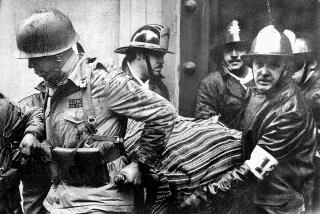Once-Secret Documents May Revise Views on Soviet Past
- Share via
WASHINGTON — “You need to hang (hang without fail, so that the public sees) at least 100 notorious kulaks, the rich, and the bloodsuckers.
“Publish their names. Take away all of their grain. Execute the hostages.
“This needs to be accomplished in such a way, that people for hundreds of miles around will see, tremble, know and scream out: let’s choke and strangle those blood-sucking kulaks.”
--Vladimir I. Lenin, 1918
The order by Russian Communist leader Vladimir I. Lenin helps dispel the widespread myth, believed by many Communists, that the “good” revolution begun by Lenin went sour during the reign of Joseph Stalin, says Librarian of Congress James H. Billington.
“The bad Lenin was hidden,” he says.
Lenin’s memo on the kulaks--relatively well-off farmers who profited from the labor of poorer peasants and opposed Soviet collectivization of the land--is one of 300 formerly secret documents, photographs and films from the Russian archives now on view at the Library of Congress. They have been released by orders of Russian President Boris N. Yeltsin as part of the nation’s new democratization.
From the earliest days of the bloody Bolshevik revolution through the 1991 crackdown on Lithuanian dissidents as the Soviet empire was falling apart, “Revelations from the Russian Archives” chronicles 75 years of totalitarian repression.
The exhibit, here through July 16 before moving to Moscow, details the horrors of the gulag system, the Cuban missile crisis, the explosion at the Chernobyl nuclear power plant, relations between Soviet and American Communists and the taking of American prisoners during World War II.
It includes documents which, according to the Soviet regime, “should never have found their way into the hands of historians, journalists, all those who are interested in the real history of our age,” said Rudolf G. Pikhoya, the Russians’ chief archivist.
It was Pikhoya, Billington said, who saved the documents when leaders of a 1991 coup that briefly toppled Mikhail S. Gorbachev attempted to destroy them.
Their release shows that “Boris Yeltsin and his supporters realize that open access to knowledge is essential to democracy,” he said.
The records contain extraordinary detail. One memo inventories the contents of Stalin’s apartment three years after his death, down to the number of pencils and pairs of underwear.
But the documents released so far represent only a fraction of those that exist. The archives contained more than 100 million documents, all labeled “secret, top secret, completely secret, and of exceptional importance,” Pikhoya said.
The documents--drawn from the KGB, presidential, Central Committee and other official files, will lead to “some important revisions of history,” Billington predicted.
In one memo to the Soviet Central Committee, then-KGB chief Yuri V. Andropov charged in 1979 that there were “serious deficiencies” in construction of the Chernobyl nuclear power plant. That was seven years before an explosion and fire.
One 1991 memo, dated the day that seven Lithuanian protesters were injured by Soviet troops in an effort to take over buildings in Vilnius, states that “on the whole, this operation was carried out without violent clashes.” Two days later, 15 Lithuanians were killed in a Soviet crackdown.
The exhibit includes a list of payments made to American Communist John Reed, author of “Ten Days That Shook the World,” providing apparent evidence that the Soviet government was bankrolling an attempted Bolshevik overthrow of the U.S. government in 1919 and 1920.
From the mundane to the tragic, the exhibit captures the full scope of Soviet history. There are photographs of the Stalin family at their dacha, Communist Party membership cards for leaders from Stalin to Gorbachev, lists of banned writers and decrees authorizing the forced resettlement of more than 1.5 million ethnic minorities.
More to Read
Sign up for Essential California
The most important California stories and recommendations in your inbox every morning.
You may occasionally receive promotional content from the Los Angeles Times.









